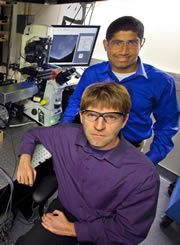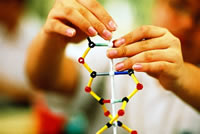


Conventional biological wisdom holds that living cells interact with their environment through an elaborate network of chemical signals. As a result many therapies for the treatment of cancer and other diseases in which cell behavior goes awry focus on drugs that block or disrupt harmful chemical signals. Now, a new road for future therapies may have been opened with scientific evidence for a never-before-seen way in which cells can also sense and respond to physical forces.
Jay Groves, of the Physical Biosciences Division, and his student, Pradeep Nair, were co-authors of a Science paper in which it was shown that the biochemical activity of a key player in cancer metastasis can be altered by the application of a direct physical force. This research presents a potential new road for future cancer therapies and also suggests how the activity of cancer cells can be affected by surrounding tissue. Other co-authors of the paper included Joe Gray, director of the Life Sciences Division. More>
 Access the video glossary from the Lab’s homepage to find new entries on “Light Source” by Bob Schoenlein and “Attosecond” by Steve Leone, the latest in a collection of clips designed to help the public become familiar with terms they will be seeing more frequently as the Lab’s Next Generation Light Source initiative proceeds. Already in the glossary are related entries on “Free Electron Laser” by John Corlett, “Photon” by Ben Feinberg, and “Synchrotron Radiation” by Michael Martin.
Access the video glossary from the Lab’s homepage to find new entries on “Light Source” by Bob Schoenlein and “Attosecond” by Steve Leone, the latest in a collection of clips designed to help the public become familiar with terms they will be seeing more frequently as the Lab’s Next Generation Light Source initiative proceeds. Already in the glossary are related entries on “Free Electron Laser” by John Corlett, “Photon” by Ben Feinberg, and “Synchrotron Radiation” by Michael Martin.
As part of the Earth Sciences Distinguished Scientist Seminar, John W. Valley of the Department of Geoscience at University of Wisconsin-Madison will speak today (March 12) at 10:30 a.m. in the Building 50 Auditorium. Valley is the Van Hise Professor of Geology at the University of Wisconsin–Madison, where he established the WiscSIMS Laboratory for Stable Isotope Geochemistry. His interests include the early Earth, astrobiology, mountain belts, and paleoclimatology.
 Tech Transfer: Licensed Semiconductor Nanocrystals Put to New Use
Tech Transfer: Licensed Semiconductor Nanocrystals Put to New UseLife Technologies Corporation announced early stage results from its single molecule sequencing technology, a technology for rapidly delivering targeted genomic sequence data for use in research laboratories and clinical settings. The core sequencing engine is based on the Qdot(R) nanocrystals technology developed at Berkeley Lab by Paul Alivisatos and colleagues at the Materials Sciences Division. More>
 People: Jean Fréchet to Head Research at King Abdullah University of Science and Technology
People: Jean Fréchet to Head Research at King Abdullah University of Science and Technology[ScienceInsider] Jean Fréchet, a senior scientist in the Materials Sciences Division, has been named vice president for research at the new King Abdullah University of Science and Technology (KAUST) in Thuwal, Saudi Arabia. A multibillion-dollar project of the Saudi leader, KAUST has replaced the traditional departmental structure with nine interdisciplinary research centers focused on economically relevant topics such as plant stress genomics, water desalination, and renewable energy. In his new position, Fréchet will oversee the current centers and help launch new ones. More>
As previously announced in Today at Berkeley Lab, Lab employees who are members of the University of California Retirement Plan (UCRP) will restart contributions to the pension plan. The contributions will start in mid-April and apply to May earnings. To assist staff with this transition, the Lab’s HR Benefits group will give information sessions throughout March; the first ones will be a live presentation on March 15 at 2 p.m. in the Building 50 Auditorium and a webinar session on March 18 at 2 p.m. Click here for the full schedule. Registration is required for the webinar session.
Construction activities scheduled for this weekend (March 13 and 14) will close Lawrence Road from south of the Guest House (B23) to the Fire Station (B48). Please use McMillan Road to access the southern portion of the site. Contact Kirk Haley (x4171) or Tim Kemper (x6917) for additional information.
Today at Berkeley Lab encourages comments, suggestions, and story ideas. Please send them here.
TABL is produced by Public Affairs' Communications Group